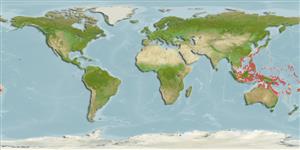Common names from other countries
Environment: milieu / climate zone / depth range / distribution range
Ecologia
. Tropical
Western Central Pacific: Philippines, Palau and Indonesia.
Length at first maturity / Tamanho / Peso / Idade
Maturity: Lm ? range ? - ? cm Max length : 4.5 cm ShH macho/indeterminado; (Ref. 821)
Length based on occurence record; to be replaced with better reference.
Life cycle and mating behavior
Maturidade | Reprodução | Desova | Ovos | Fecundidade | Larvas
Members of the order Neotaenioglossa are mostly gonochoric and broadcast spawners. Life cycle: Embryos develop into planktonic trocophore larvae and later into juvenile veligers before becoming fully grown adults.
Springsteen, F.J. and F.M. Leobrera. 1986. (Ref. 821)
Status na Lista Vermelha da IUCN (Ref. 130435)
Status no CITES (Ref. 108899)
Not Evaluated
Not Evaluated
Uso pelos humanos
| FishSource |
Ferramentas
Mais informação
Idade/TamanhoCrescimentoComprimento-pesoComprimento-comprimentoMorfologiaLarvasAbundância
Fontes da internet
Estimates based on models
Preferred temperature
(Ref.
115969): 25 - 29.3, mean 28.5 (based on 1348 cells).
Vulnerabilidade
Low vulnerability (10 of 100).
